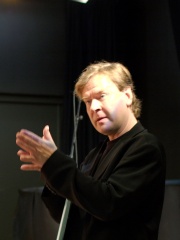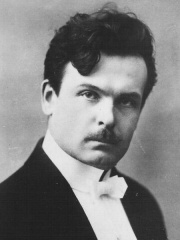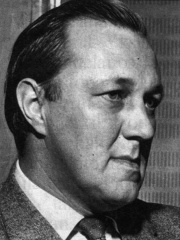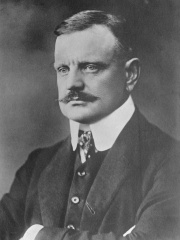

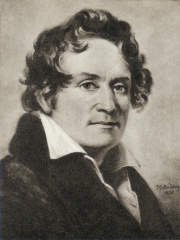
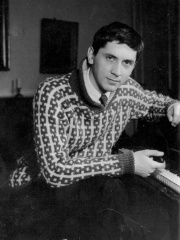

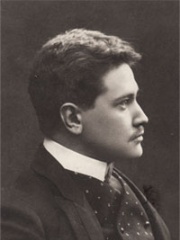
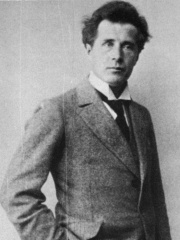
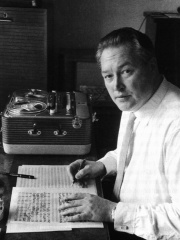
The Most Famous
COMPOSERS from Finland
This page contains a list of the greatest Finnish Composers. The pantheon dataset contains 1,451 Composers, 13 of which were born in Finland. This makes Finland the birth place of the 18th most number of Composers behind Switzerland, and Norway.
Top 10
The following people are considered by Pantheon to be the top 10 most legendary Finnish Composers of all time. This list of famous Finnish Composers is sorted by HPI (Historical Popularity Index), a metric that aggregates information on a biography's online popularity. Visit the rankings page to view the entire list of Finnish Composers.

1. Jean Sibelius (1865 - 1957)
With an HPI of 80.86, Jean Sibelius is the most famous Finnish Composer. His biography has been translated into 88 different languages on wikipedia.
Jean Sibelius (; Finland Swedish: [ˈʃɑːn siˈbeːliʉs] ; born Johan Julius Christian Sibelius; 8 December 1865 – 20 September 1957) was a Finnish composer of the late Romantic and early modern periods. He is widely regarded as his country's greatest composer, and his music is often credited with having helped Finland develop a stronger national identity when the country was struggling from several attempts at Russification in the late 19th century. The core of his oeuvre is his set of seven symphonies, which, like his other major works, are regularly performed and recorded in Finland and countries around the world. His other best-known compositions are Finlandia, the Karelia Suite, Valse triste, the Violin Concerto, the choral symphony Kullervo, and The Swan of Tuonela (from the Lemminkäinen Suite). His other works include pieces inspired by nature, Nordic mythology, and the Finnish national epic, the Kalevala; over a hundred songs for voice and piano; incidental music for numerous plays; the one-act opera The Maiden in the Tower; chamber music, piano music, Masonic ritual music, and 21 publications of choral music. Sibelius composed prolifically until the mid-1920s, but after completing his Seventh Symphony (1924), the incidental music for The Tempest (1926), and the tone poem Tapiola (1926), he stopped producing major works in his last 30 years—a retirement commonly referred to as the "silence of Järvenpää" (the location of his home). Although he is reputed to have stopped composing, he attempted to continue writing, including abortive efforts on an eighth symphony. In later life, he wrote Masonic music and re-edited some earlier works, while retaining an active but not always favourable interest in new developments in music. Although his early retirement has perplexed scholars, Sibelius was clear about its cause — he simply felt he had written enough. The Finnish 100 mark note featured his image until 2002, when the euro was adopted. Since 2011, Finland has celebrated a flag flying day on 8 December, the composer's birthday, also known as the Day of Finnish Music. In 2015, in celebration of the 150th anniversary of Sibelius's birth, a number of special concerts and events were held, especially in Helsinki, the Finnish capital.

2. Kaija Saariaho (1952 - 2023)
With an HPI of 63.77, Kaija Saariaho is the 2nd most famous Finnish Composer. Her biography has been translated into 32 different languages.
Kaija Anneli Saariaho (Finnish: [ˈkɑi̯jɑ ˈsɑːriɑho]; née Laakkonen; 14 October 1952 – 2 June 2023) was a Finnish composer based in Paris, France. During the course of her career, Saariaho received commissions from the Lincoln Center for the Kronos Quartet and from IRCAM for the Ensemble Intercontemporain, the BBC, the New York Philharmonic, the Salzburg Music Festival, the Théâtre du Châtelet in Paris, and the Finnish National Opera, among others. In a 2019 composers' poll by BBC Music Magazine, Saariaho was ranked the greatest living composer. Saariaho studied composition in Helsinki, Freiburg, and Paris, where she also lived since 1982. Her research at the Institute for Research and Coordination in Acoustics/Music (IRCAM) marked a turning point in her music away from strict serialism towards spectralism. Her characteristically rich, polyphonic textures are often created by combining live music and electronics.

3. Bernhard Crusell (1775 - 1838)
With an HPI of 63.58, Bernhard Crusell is the 3rd most famous Finnish Composer. His biography has been translated into 21 different languages.
Bernhard Henrik Crusell (15 October 1775 – 28 July 1838) was a Swedish-Finnish clarinetist, composer and translator, "the most significant and internationally best-known Finnish-born classical composer and indeed, – the outstanding Finnish composer before Sibelius".

4. Einojuhani Rautavaara (1928 - 2016)
With an HPI of 63.55, Einojuhani Rautavaara is the 4th most famous Finnish Composer. His biography has been translated into 30 different languages.
Einojuhani Rautavaara (Finnish pronunciation: [ˈei̯noˌjuhɑni ˈrɑu̯tɑˌʋɑːrɑ] ; 9 October 1928 – 27 July 2016) was a Finnish composer of classical music. Among the most notable Finnish composers since Jean Sibelius (1865–1957), Rautavaara wrote a great number of works spanning various styles. These include eight symphonies, nine operas and fifteen concertos, as well as numerous vocal and chamber works. Having written early works using 12-tone serial techniques, his later music may be described as neo-romantic and mystical. His major works include his first piano concerto (1969), Cantus Arcticus (1972) and his seventh symphony, Angel of Light (1994).
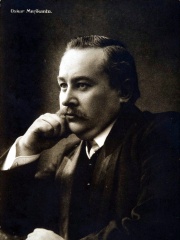
5. Oskar Merikanto (1868 - 1924)
With an HPI of 61.50, Oskar Merikanto is the 5th most famous Finnish Composer. His biography has been translated into 23 different languages.
Oskar Merikanto (pronounced [ˈoskɑr ˈmeriˌkɑnto] ; born Frans Oskar Ala-Kanto; 5 August 1868 – 17 February 1924) was a Finnish composer, music critic, pianist, and organist. As a composer, Merikanto was primarily a miniaturist, and his extensive œuvre includes songs and piano pieces (he wrote over 100 of each). Of the latter, he is best remembered for: Summer Evening Waltz (Kesäillan valssi, Op. 1), Romance (Romanssi, Op. 12), Summer Evening Idyll (Kesäillan idylli, Op. 16/2), Valse lente (Op. 33), and Idyll (Idylli, Op. 73/1). Merikanto also wrote three operas: The Maiden of the North (Pohjan neiti, 1898), which retains a degree of historical significance as the first opera composed to a Finnish libretto; The Death of Elina (Elinan surma, 1910); and Regina von Emmeritz (1920). However, Merikanto's operas have entered neither the domestic nor the international repertoires. As a music critic, Merikanto was associated with the Finnish-language, liberal, nationalist newspaper Päivälehti.

6. Martin Wegelius (1846 - 1906)
With an HPI of 59.73, Martin Wegelius is the 6th most famous Finnish Composer. His biography has been translated into 17 different languages.
Martin Wegelius (10 November 1846 – 22 March 1906) was a Finnish composer and musicologist, primarily remembered as the founder, in 1882, of the Helsinki Music Institute, now known as the Sibelius Academy. Wegelius studied in Leipzig, Vienna, and Munich. He had intended to pursue a career as a composer and wrote a handful of orchestral works and a significant number of chamber and vocal works. He was a particular admirer of Wagner but wrote predominantly in the Romantic style. After founding the Institute, he had little time for composing and appears to have concentrated exclusively on teaching. Graduates of Wegelius' Institute include Jean Sibelius and Agnes Tschetschulin. He is often compared with his contemporary and rival Robert Kajanus, founder of the Helsinki Philharmonic Orchestra (initially the Helsinki Orchestral Association), the first professional symphony orchestra in the Nordic countries. He is buried in the Hietaniemi Cemetery in Helsinki.

7. Selim Palmgren (1878 - 1951)
With an HPI of 59.69, Selim Palmgren is the 7th most famous Finnish Composer. His biography has been translated into 19 different languages.
Selim Gustaf Adolf Palmgren (16 February 1878 – 13 December 1951) was a Finnish composer, pianist, and conductor. Palmgren was born in Pori, Finland, February 16, 1878. He studied at the Conservatory in Helsinki from 1895 to 1899, then continued his piano studies in Berlin with Ansorge, Berger and Busoni. He conducted choral and orchestral societies in his own country and made several very successful concert tours as a pianist in the principal cities of Finland and Scandinavia, appearing also as a visiting conductor. In 1921, he went to the United States, where he taught composition at the Eastman School of Music, later returning to Finland, where he died in Helsinki, aged 73. Palmgren was married to the opera singer Maikki Järnefelt from 1910 to her death in 1929.

8. Leevi Madetoja (1887 - 1947)
With an HPI of 59.19, Leevi Madetoja is the 8th most famous Finnish Composer. His biography has been translated into 18 different languages.
Leevi Antti Madetoja (pronounced [ˈleːʋi ˈmɑdetˌojɑ]; 17 February 1887 – 6 October 1947) was a Finnish composer, music critic, conductor, and teacher of the late-Romantic and early-modern periods. He is widely recognized as one of the most significant Finnish contemporaries of Jean Sibelius, under whom he studied privately from 1908 to 1910. The core of Madetoja's oeuvre consists of a set of three symphonies (1916, 1918, and 1926), arguably the finest early-twentieth century additions to the symphonic canon of any Finnish composer, Sibelius excepted. As central to Madetoja's legacy is Pohjalaisia (The Ostrobothnians, 1923), proclaimed Finland's "national opera" following its successful 1924 premiere and, even today, a stalwart of the country's repertoire. Other notable works include an Elegia for strings (1909); Kuoleman puutarha (The Garden of Death, 1918–21), a three-movement suite for solo piano; the Japanisme ballet-pantomime, Okon Fuoko (1927); and, a second opera, Juha (1935). Madetoja's fourth symphony, purportedly lost in 1938 at a Paris railway station, never materialized. Acclaimed during his lifetime, Madetoja today is seldom heard outside the Nordic countries, although his music has in recent decades enjoyed a renaissance, as the recording projects of a number of Nordic orchestras and conductors evidence. His idiom is notably introverted for a national Romantic composer, a blend of Finnish melancholy, folk melodies from his native region of Ostrobothnia, and the elegance and clarity of the French symphonic tradition, founded on César Franck and guided by Vincent d'Indy. His music also reveals Sibelius's influence. Madetoja was also an influential music critic, primarily with the newspaper Helsingin sanomat (1916–32), in which he reviewed the music scenes of France and Finland, praising Sibelius in particular. In 1918, he married the Finnish poet L. Onerva; their marriage was tempestuous and remained childless. His health failing due to alcoholism, Madetoja died from a heart attack on 6 October 1947 in Helsinki.

9. Erkki Aaltonen (1910 - 1990)
With an HPI of 58.08, Erkki Aaltonen is the 9th most famous Finnish Composer. His biography has been translated into 16 different languages.
Erkki Aaltonen (17 August 1910 – 8 March 1990) was a Finnish composer.
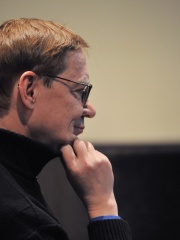
10. Kalevi Aho (b. 1949)
With an HPI of 57.78, Kalevi Aho is the 10th most famous Finnish Composer. His biography has been translated into 18 different languages.
Kalevi Ensio Aho (born 9 March 1949) is a Finnish composer.
People
Pantheon has 13 people classified as Finnish composers born between 1775 and 1958. Of these 13, 2 (15.38%) of them are still alive today. The most famous living Finnish composers include Kalevi Aho, and Magnus Lindberg. The most famous deceased Finnish composers include Jean Sibelius, Kaija Saariaho, and Bernhard Crusell.
Living Finnish Composers
Go to all RankingsDeceased Finnish Composers
Go to all RankingsJean Sibelius
1865 - 1957
HPI: 80.86
Kaija Saariaho
1952 - 2023
HPI: 63.77
Bernhard Crusell
1775 - 1838
HPI: 63.58
Einojuhani Rautavaara
1928 - 2016
HPI: 63.55
Oskar Merikanto
1868 - 1924
HPI: 61.50
Martin Wegelius
1846 - 1906
HPI: 59.73
Selim Palmgren
1878 - 1951
HPI: 59.69
Leevi Madetoja
1887 - 1947
HPI: 59.19
Erkki Aaltonen
1910 - 1990
HPI: 58.08
Toivo Kuula
1883 - 1918
HPI: 57.14
Joonas Kokkonen
1921 - 1996
HPI: 55.43
Overlapping Lives
Which Composers were alive at the same time? This visualization shows the lifespans of the 11 most globally memorable Composers since 1700.

